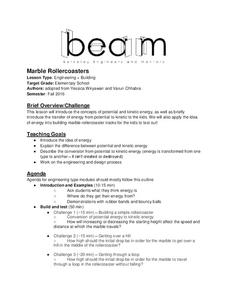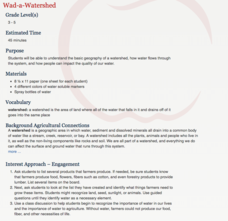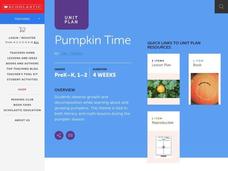Curated OER
The Water Cycle
Your class sets up a mini water cycle model to examine the process. Then they watch an animation, following a water molecule through the cycle. A well-developed lab sheet guides learners through the lesson and a PowerPoint presentation...
Cornell University
Catapults
Ready, aim, fire! Launch to a new level of understanding as scholars build and test their own catapults. Learners explore lever design and how adjusting the fulcrum changes the outcome.
Teach Engineering
Amusement Park Ride: The Ups and Downs in Design
Groups design the ultimate roller coaster by considering potential and kinetic energy. They test their designs using marbles and then go on to rate each group's design based on aesthetics, loop diameter, and cost.
NOAA
It All Runs Downhill
Examine how pollution makes its way into an ocean with help from a model watershed. Scholars use household items to recreate a mini-watershed, equipped with pollutants, that when mixed with rain drain into a model's body of water. After...
University of California
Marble Rollercoasters
Don't let your classes coast through school! Engage them in their learning as they build their own roller coasters to study potential and kinetic energy. Young scholars complete several challenges that require them to consider the...
Curated OER
Insects A-Z!
Alphabet insects! Who has ever heard of such a thing? Get ready because your class is going to research insects that start with a specific letter of the alphabet. In small groups, they'll use the Internet and reference texts to locate...
Stanford University
Solstice and Equinox Season Model
How can December 21 be the shortest day of the year when all days are 24 hours long? Pupils see how to build a model showing the differences between winter and summer solstices and equinoxes. Using this model, classes can then discuss...
Cornell University
Sun or Water? or Both?
Over the course of 10 days, young scientists observe their cups of seed and soil—one that gets sun and water and one that gets no sun and only water. Then they reflect on the results of the experiment to determine if their hypothesis was...
University of Wisconsin
Identifying Your Soil for Rain Gardens
Teach your class the descriptive characteristics of soil. Provide information about particle size and a flow chart for assessing texture. Soil scientists then analyze samples and hypothesize which would be the best type for a rain...
Texas State Energy Conservation Office
Investigation: Concept Mapping Fuels
After reading an article, "Fuels for Everything," collaborative groups create a concept map poster of the transportation and non-transportation fuels. This makes a strong introduction to the different types of fuels used for transportion...
National Nanotechnology Infrastructure Network
Small Scale Sculpting: Etch Lab
Make works of art using a vintage yet effective etching strategy. The surface of a semiconductor chip has specific patterns formed through a process called etching. Through a lab investigation, young scholars recreate that process on a...
Agriculture in the Classroom
Wad-a-Watershed
What kind of impact do humans have on watersheds? Find out in a instructional activity that defines, explores, and promotes ways to protect our watersheds. The ultimate goal of the instructional activity is for learners to discover how a...
Polar Trec
Ice Cores: Modeling Ice Sheets
Ice cores provide scientists with knowledge of historic melt layers, air temperatures, greenhouse gases, and climate stability. Scholars work in groups to build layers representing snow and ice over thousands of years. Then, groups...
Beyond Benign
Green"er" Precipitation Reaction
All sodium carbonate may not have the same amount of carbonate, but it should have the same percent. Learners write and balance an equation to predict the chemical reaction between sodium carbonate and zinc acetate. Through the lab...
Curated OER
How Do Things Fall?
Students observe falling objects. They discover the rate of falling is based on air resistance and not the weight of the objects. They discuss how engineers use this type of information to design aerodynamic shapes.
Curated OER
Using Triangulation to Locate Meteorites from Witnessed Falls
High schoolers participate in a mock investigation in which they must interview and record data given by 3 people ("witnesses") in an effort to triangulate the location of a meteorite.
Curated OER
Fall of the Leaning Tower
Students participate in a hands-on experiment with different soil structures and the ability of each to carry a specific load. Students take a core soil sample and describe its content layers. Students stand bricks in the soil overnight...
Curated OER
Snapshot Day Definitions & Activities
In this watershed activity, students read through related definitions and complete 17 short answer questions about deposition and erosion in the Hudson River.
Curated OER
Ranger Rick: Dissect a Pumpkin
In this pumpkin activity worksheet, students examine pumpkins inside and out and then respond to 4 short answer questions regarding their observations.
Curated OER
The Tallest Plants ... are Trees!
A fabulous worksheet about trees awaits your students. They read a lengthy selection on the various parts of trees, then complete 13 fill-in-the-blank and matching questions about what they have read. An excellent reading comprehension...
Curated OER
De"compost"ition
Learners develop an understanding of the decomposition process and the parameters which influence the rate at which it occurs.
Curated OER
Pumpkin Time
In these two lessons, science learners participate in various activities involving pumpkins. They investigate and research the life cycle of a pumpkin. They observe pumpkin growth and decomposition. Finally, they estimate and measure...
Curated OER
Newton's Laws 8th Grade Activities
Eighth graders experiment with Newton's Laws by comparing the falling of different objects with different masses. Students work in teams and rotate through four different stations recording their hypotheses and observations as they go.
Curated OER
The Science of Weather: Humidity makes air feel even hotter.
Students examine the effects of heat and humidity. In this weather lesson, students read a chart to determine the effects heat and humidity can have on the human body. This lesson includes an optional extension activity using a newspaper.

























